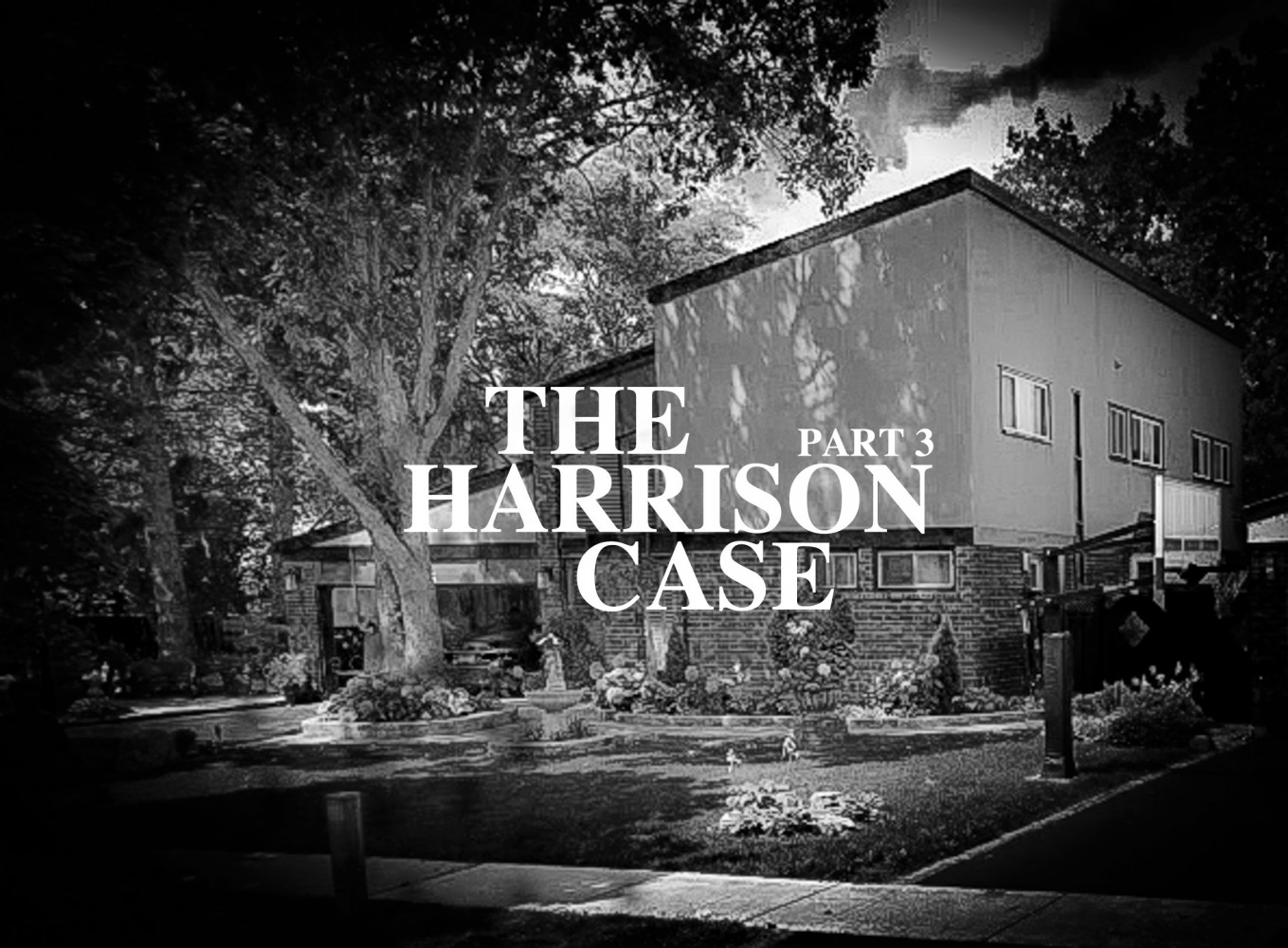
PART 3 - The Harrison murders: Peel police finally catch a killer, but expose their own failures
On a late August morning in 2013, the cleaning lady at 3635 Pitch Pine Crescent in Mississauga went about her duties, unaware that in one of the rooms, a man was still in bed, the sheets tucked around him, a pillow over his head.
He was dead, killed overnight.
When a co-worker of Caleb Harrison, who also lived in the home, arrived looking for him because he didn’t show up for work, he and the cleaner entered his room and found him in repose. They called 911.

The Mississauga family home where Bill, Bridget and Caleb Harrison were found dead four years apart
Compared to the investigations into the deaths of Caleb’s adoptive parents, Bill and Bridget, who were found dead inside the same house, first his father in 2009 and then his mother in 2010, things moved incredibly fast as soon as police arrived on the scene.
When the sheets were pulled back, the coroner identified a number of injuries to Caleb’s body, all pointing to a suspicious death. They included:
- Abrasions under the chin.
- Bruising on the neck.
- Two scratch marks on the chest and possible abrasions on his back by the armpit.
- Swollen knuckles on his right hand.
The evidence was hauntingly similar to his mother’s death. Caleb’s post-mortem found several signs of strangulation, including a broken hyoid bone, and damage to the cartilage around his voice box.
PART 1 - The Harrison murders: How did Peel Regional Police investigators miss the obvious?
PART 2 - The Harrison murders: Failing to catch a killer
There were signs of a struggle inside his room along with certain aspects of the crime scene that looked staged – and all too familiar.
These physical clues were combined with the recent history around Bill and Bridget’s deaths. An internal Peel police Administrative Review Team released a 123-page report in May, probing how the force mishandled the entire Harrison file. It says investigators “quickly” identified the similarities around Caleb’s death.
It propelled Peel police officers to immediately commit extensive investigative resources to the case. A Major Case Management Team led by members of the Homicide Bureau was formed. What should have been done after the murder of Bridget Harrison, which investigators deemed an accident, was now being done after her son was killed inside the same home.
The suspects were identified quickly.
In an interview with a family friend, right after the body was found in bed, police learned that a 50-50 custody arrangement between Caleb and his ex-partner Melissa Merritt and their two children was set to expire that day. Caleb was preparing to regain full custody.
The timing was crucial, and it linked Caleb’s death to similar circumstances around the deaths of his parents.
Those close to the Harrison family knew about the vicious custody battle between the two parents. A neighbour who lived across the street from the Harrisons described Merritt as a “nightmare for the family” and told investigators she had always been suspicious about Bill and Bridget’s deaths.
Bill was found in the bathroom the same day Merritt and her boyfriend, Chris Fattore, abducted the children and fled to Nova Scotia in 2009, breaching the custody arrangement. This all took place while Caleb was incarcerated.
Almost exactly a year later, Bridget was found dead at the foot of the main-floor staircase, the day before she was to deliver a victim impact statement in the parental abduction trial after Merritt and Fattore were caught.
Despite signs of wrongdoing on both of their bodies and red flags raised by coroners, police investigators saw no connection, decided there was no foul play and stopped the investigations.
The evening after Caleb’s body was found, detectives knocked on the door of Merritt and Fattore’s home to tell them the death had been ruled a homicide. Both declined to provide statements.
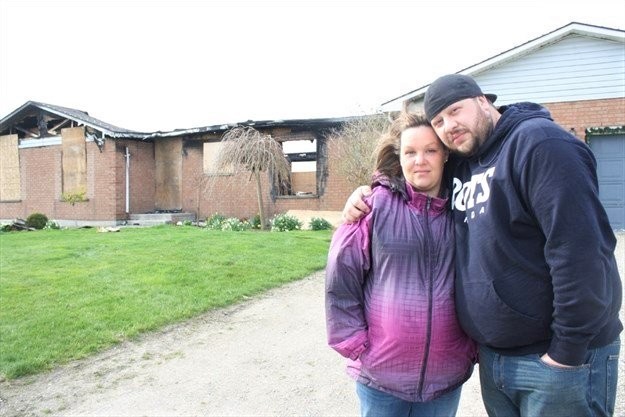
Melissa Merritt and Chris Fattore
Peel Police did not let the pair off so easily, this time.
With the benefit of hindsight and evidence that was right in front of them from the two previous deaths, both were quickly identified as suspects.
Peel officers were about to catch the killer who murdered Caleb and Bridget Harrison.
“The full implementation of the Major Case Management Model early in the investigation enabled effective governance of this protracted investigation,” the internal review states.
In terms of the end result – Merritt and Fattore behind bars – this seems like an accurate statement. However, it paves over the disturbing incompetence displayed by Peel police investigators who made glaring missteps along the way. Critical evidence was repeatedly excluded in the case and basic homicide work was done in a shoddy manner. Little had been done by senior officers to ensure the proper management of two connected cases. The file had been bungled, passed from hand to hand and ignored by officers distracted with other cases.
Without a change to the processes and practices that led to these tragic mistakes, it could very well happen again. Another guilty person might walk away. Another innocent life might be lost at the hands of a killer who should have been locked away.
Within a week of Caleb’s death, Peel detectives seized Merritt’s cell phone. A GPS tracker was installed on her vehicle, “cast off” DNA was collected and garbage bags were seized from the front of the couple’s house. Inside, investigators found black and white velcro shoes in a grey plastic Walmart bag, along with a pair of black latex gloves. The sewer drains around the Harrison home were swept for evidence.
The timeline detailed by Peel Police’s Administrative Review Team makes it clear from the onset of the investigation that Merritt and Fattore were the prime suspects.
By August 27, 2013, four days after Caleb’s body was found, both had provided statements to investigators and gave stories for their whereabouts on the night he was killed.
Merritt claimed the two of them were at home in bed, awoken at 4 a.m. by their youngest child, then again at 6 a.m. Both were placed under police surveillance.
With every witness police interviewed, more layers of evidence emerged. They described the fear the Harrison family had for Caleb’s former partner, and the extent of concern that had been voiced about her behaviour, since the problems began almost a decade before the final member of the family was killed.
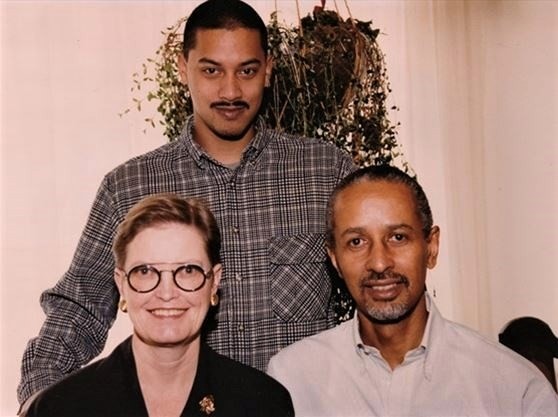
Bridget and Bill Harrison, with their son Caleb
Police learned Merritt had previously accused Caleb of sexually assaulting the children, a claim that was investigated and determined to be a fabrication. Aunts and uncles in the Harrison family repeatedly pointed to Merritt as having something to do with not only Caleb’s murder, but also Bridget’s.
Their fear ran so deep, they insisted Peel Police provide them with protection during the investigation, and a security arrangement was made.
Family friends had their suspicions, too. On September 3, investigators interviewed one who “strongly expected” Merritt had something to do with Caleb and Bridget’s death. He recalled that when Merritt and Fattore abducted the kids and took off to Nova Scotia after Bill’s death, his wife had offered to help look after the children. Bridget declined.
“Thanks, for the offer, but it’s far too dangerous,” she had said.
That same day, investigators discovered from Merritt and Fattore’s bank records that the shoes found in the trash were purchased by Fattore at the Mississauga Road Walmart around 9:30 p.m. on the night before Caleb’s death.
Evidence quickly began to pile up against the couple.
On September 9, a search of Merritt’s cell phone revealed a downloaded 28-page document detailing the hardware and functionality of the same type of security lock at the Harrison home.
The document was last opened July 2013, a month before Caleb’s death. On the same day the phone was searched, investigators visited the couple’s Brampton home, but it was empty. During a perimeter check, an officer photographed the door lock on the residence. This was done without a warrant and at trial it was deemed a violation of Merritt’s Charter rights.
The property owner said Fattore and Merritt had rented the home with a one-year lease starting the beginning of August, three weeks before Caleb was found. While it did not appear the pair had moved out of the home, that very day, Merritt had made an application for sole custody of the children – and the GPS tracker on their vehicle showed they were on their way to Nova Scotia, again. The pair returned home a few days later.
However, before the end of the month, police would learn from Fattore’s probation officer that they were planning a move to Nova Scotia so he could take a job as a farm hand.
They moved before the end of the month, but left a lot behind.
Fattore had hired three trucks to go to the Brampton home to collect what was left behind. A search warrant executed at the home in early October allowed police to enter. They discovered belongings, including USB devices and two laptop computers among other items that were seized.
They provided a goldmine of evidence that proved incredibly damning. The documents and data on the devices included information about:
- How long until someone dies from being choked: April 1, 2010 (20 days before Bridget’s death)
- How to get through a locked patio door: August 23, 2011
- Can you taste rat poison - no date available
- Bill Harrison: August 6, 2010
- Repeated searches for “Gross pictures of dead bodies”, “dead body pictures”, “pictures of dead bodies” in April 2010
- Bridget Harrison: Two days after her death
- Bridget Harrison: Six days after her death
- If a grandparent has custody of children and they die which of the parents gets the kids - Feb. 11, 2010 (2 months before Bridget’s death)
- Easy ways to kill and get away with it: July 22, 2011
- Bill Harrison: April 24, 2010
- Belinda Bridget Harrison: April 30, 2010
- Bridget Harrison death: Five days after her death
- How do you know if your home phone is tapped: May 6, 2010
- How to extract poison from Oleander plant: July 17, 2011
- How to extract poison from plant: July 18, 2011
- How to make poison liquid: July 18, 2011
The information found stored on the devices could have been vital pieces of the puzzle for Peel police and Crown prosecutors, but was later deemed inadmissible for the trial because of how the force’s investigators handled the evidence.
Because ownership of the electronic devices was not initially confirmed, police could not attribute the searches to either Fattore or Merritt. In order to do so, investigators took part in what Justice Fletcher Dawson described as a “cover-up”.
When investigators tried to connect the searches to either Fattore or Merritt during their probe, officers extended the limits of their search warrant and began looking at other parts of the devices, including email accounts. They viewed emails between Merritt and her lawyer – protected under solicitor-client privilege. When this came to light at trial, Peel police were not forthcoming about how this happened.
“(A) failure to disclose significant problems with the conduct of various police officers involved in this investigation appears to me to be part of a pattern,” Justice Dawson wrote. “This pattern of a lack of disclosure contributes to my conclusion that there has been an attempt in this case to cover up, minimize or reduce attention upon various aspects of problematic police activity which occurred in the course of this investigation.”
Dawson described testimony provided by officers as “disastrous”, lambasted officers for their poor note taking, and found investigators did not seem to understand the limits of their authority.
“A combination of findings of police dishonesty, misleading alteration of the investigative record, lack of disclosure and considerable negligence at various stages of the investigation by a number of officers in leadership positions within the investigation are all implicated in my ultimate decision,” Dawson wrote.
The evidence was eventually thrown out.
This was not the only problem around warrants used in the case. The search of Merritt’s cell phone, which turned up the PDF document about the same type of lock used at the Harrison home, was brought into question. At the time investigators searched the phone and discovered it, they only had a warrant to seize the device, not analyze its contents. The PDF was still deemed admissible in court.
Luckily, prosecutors didn’t need this information to get the pair convicted. By mid-November, they had secured a warrant to wire-tap Merritt and Fattore’s Nova Scotia home. The audio probes captured Fattore claiming, “I was wearing my hood, my long-sleeve hooded Cumberland hooded sweater,” while at the same time someone was Googling details about the transfer of DNA from sweat or tears.
Then on January 1, 2014, Merritt said: “You have to realize that the underlying fact of the matter is that you killed Caleb.”
“I know,” Fattore replied.
About three weeks later, the pair were arrested.
During the murder trial in 2017, the step-by-step details of how Bridget and Caleb Harrison were killed by Fattore were laid bare in court. The overwhelming evidence, much of it ignored by police officers for years, showed two people bent on destroying an entire family.
Fattore and Merritt were found guilty of first degree murder in Caleb’s death. Fattore was also guilty of Bridget’s death, but the jury was hung on whether Merritt was complicit.
Neither were found guilty in the death of Bill Harrison.
The tragic saga revealed internal problems in the Peel police force. This was not the first time investigators have been berated by the justice system for improper, or illegal police work.
Unless the many recommendations in the recent Administrative Review are heeded, nothing will change.
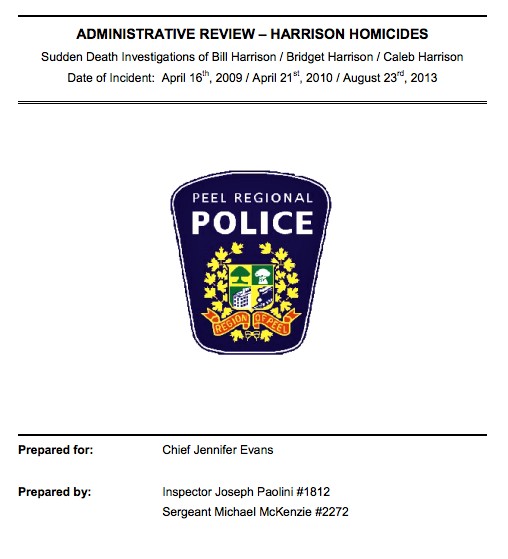
The Office of the Independent Police Review Director’s reports are not public, and The Pointer was denied access to the documents. An OIPRD spokesperson referred to confidentiality provisions in the Police Services Act.
“We cannot provide a copy of the reports or any details regarding our investigative findings,” a spokesperson said.
The Peel Regional Police were also unable to provide a status update on each of the remaining 14 recommendations in the internal review of the Harrison file. It’s unclear why this public information, stemming from the force’s own report in May, was not readily available.
The Harrison investigation was not the only case involving incompetence and wrongdoing by Peel police officers. There have been many.
In August of last year, four Peel officers pleaded guilty to attempting to obstruct justice when they lied to the court about stealing a wooden statue of a movie character from an accused drug dealer’s storage locker. The entire drug case was eventually thrown out after the charges were stayed.
The theft by officers of the law was followed by an attempt to cover up their actions, including lying on the witness stand.
“Clearly their conduct is a dark chapter for Peel police,” said Justice Bruce Durno, who presided over the trial of the officers. “It was a foolish and impulsive act in stealing the statue … But the (obstruction) offence is most serious. It struck at the heart of the justice system.”
All four drug squad officers resigned under the plea agreement.
The resulting sentencing for the former officers — one-year conditional, with six months under house arrest — led to calls for a full investigation of Peel Police’s drug squad. An internal investigation was conducted under former chief Jennifer Evans, but results have never been made public.
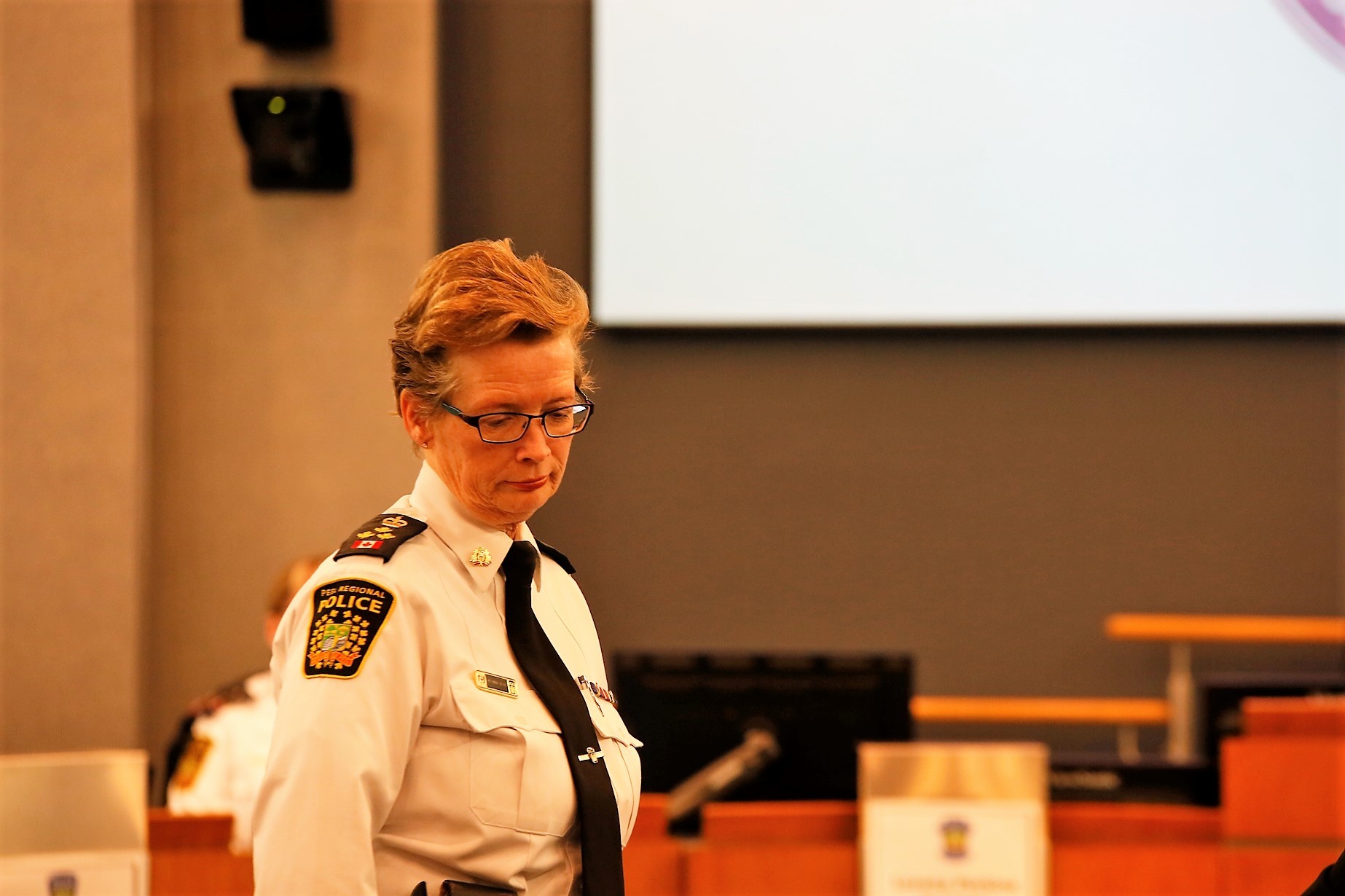
Former Peel police chief Jennifer Evans
“These are not rogue officers, these are the ‘best of the best’ — that’s how they were portrayed. So you have the ‘best of the best’ prepared to perjure themselves on three separate occasions? What does that say about that police force?” said defence lawyer Kim Schofield, at the time.
In another case, a Peel officer was caught stealing $20,000 from an accused person’s home. Instead of pursuing an investigation into the officer responsible, Peel Police, under the direction of Evans, went after the lawyer Leora Shemesh, who exposed the wrongdoing. It accused her of perjury. After being fully vindicated, Shemesh sued the Peel Police Services Board.
These are just two of many examples.
A Toronto Star investigation in 2016 found that roughly 640 Peel officers, almost one-third of the force at that time, had been disciplined for misconduct since 2010.
The alarming rate pointed to a force without any real leadership. The widespread misconduct was revealed shortly after Evans had claimed that only 2 percent of the force's officers are disciplined for misconduct. The Ontario Provincial Police (OPP), which had the second worst rate of misconduct, had roughly the same number of discipline cases during the same period, although its force was nearly three times the size of Peel’s.
A culture devoid of professional standards can have devastating consequences, in the Harrison case, it proved fatal. Other examples should have been a warning sign to police leaders.
In 2011, Ontario Superior Court Justice Douglas Gray stopped a trial after ruling that Peel police vice-officers had misled the court, falsifying evidence in a case involving human trafficking and pimping.
The charges against the defendant were thrown out, because "the state actors, the police, have been prepared to fabricate a case," Gray wrote in his decision. The actions of the Peel officers who tried to deceive the court were "an affront to decency and fair play.”
"It would be difficult to conceive of conduct that would more distinctly shock the conscience of the community than a fabrication of evidence by the police,” he wrote.
A year after that, Justice Deena Baltman addressed conduct by Peel drug squad officers in another case that could be described as even more shocking.
"The police lied under oath in order to cover up (an) illegal search and persisted in their lying when confronted with the most damning of evidence," Baltman stated in her reasons for sparing the defendant jail time in a drug trafficking case.
Referring to the attempted cover-up by Peel officers, the judge said, "All these misdeeds were calculated, deliberate and utterly avoidable." Peel officers had "colluded and then committed perjury, en masse," she said, adding: "The police showed contempt not just for the basic rights of every accused but for the sanctity of a courtroom."
With a change in leadership — Evans quit at the beginning of 2019 — it could signal a move away from a force that has denied and deflected responsibility at every turn, including in the Harrison case.
“I recognize the significant trauma that these three deaths have had on the members of the Harrison family and the community. This investigation was long, involved and transpired over ten years and before my time with Peel Police,” said current Chief Nishan Duraiappah in a brief statement when the internal Administrative Review was released in May.

Chief Nishan Duraiappah said he recognizes the "significant trauma" the case has caused for surviving members of the Harrison family
Among the proposed changes are new training requirements in sudden death investigations, implementing the Major Case Manager model in all suspicious death investigations; plus a peer review of case reports when a death is left undetermined, and the homicide bureau should be assigned to review all sudden death investigations on a monthly basis.
The OIPRD has also investigated four separate complaints related to police handling of the Harrison family murder investigations, one of which is outstanding.
While these reports are not public, Chief Duraiappah has said OIPRD revealed a number of similar themes as the internal review.
“Based on which, we have already made numerous changes, and we will continue to make more as they are identified,” Duraiappah said.
That could have been the end of it, until the Harrison family decided to speak up about continued inaction by Peel Regional Police.
Earlier this month, Harrison family members spoke with The Toronto Star, stating they would be sharing two of the completed OIPRD reports into Peel Police’s handling of the investigation, after Chief Duraiappah deemed the misconduct of officers identified in the reports to be “less serious”. These lesser misconduct offences do not require a hearing under the Police Services Act and can be handled at the divisional level, with little public awareness about any discipline.
The Pointer reached out to the Harrison family through their lawyer for an interview, but did not receive a response ahead of publication.
In this case, two officers have come forward to accept some responsibility for the failures in the investigation into Bridget Harrison’s death.
“The officers agreed to waive the confidentiality clause in the interest of transparency,” stated Peel Police spokesperson Akhil Mooken.
Inspectors Sean Brennan and Gregory Amoroso have “accepted responsibility” for problems identified in the OIPRD reports, including failing to follow-up on the investigation after being seconded to other tasks. Perhaps most significant was the lack of attention to a possible homicide after Amoroso incorrectly wrote in a report that no evidence of foul play had been found in Bridget’s death.
This was not the case.
The Harrison family has stated a disciplinary hearing is needed following the OIPRD’s findings, and are calling for more transparency from Peel Police, adding the officers' punishment — a loss of days off — is less than appropriate. They feel Peel police are simply sweeping the issue under the rug.
A request for comment sent to the Chief through Peel police’s communications department was not responded to, and the status of the outstanding recommendations from the review remains unclear.
“There were a few [recommendations] that had to wait until the OIPRD investigation was completed and those are now in the process of being implemented. I don’t have an exact number of what is still to be completed,” Mooken said.
The Harrison murder file is thick, and the loss of three Mississauga residents inside their family house on a quiet crescent has shocked the community. The conduct of Peel police was almost as troubling as the three deaths in four years, and the ability of a killer to roam free until he struck again.
Such a tragic, avoidable story hopefully won’t have to be written again.
Email: [email protected]
Twitter: @JoeljWittnebel
Submit a correction about this story


